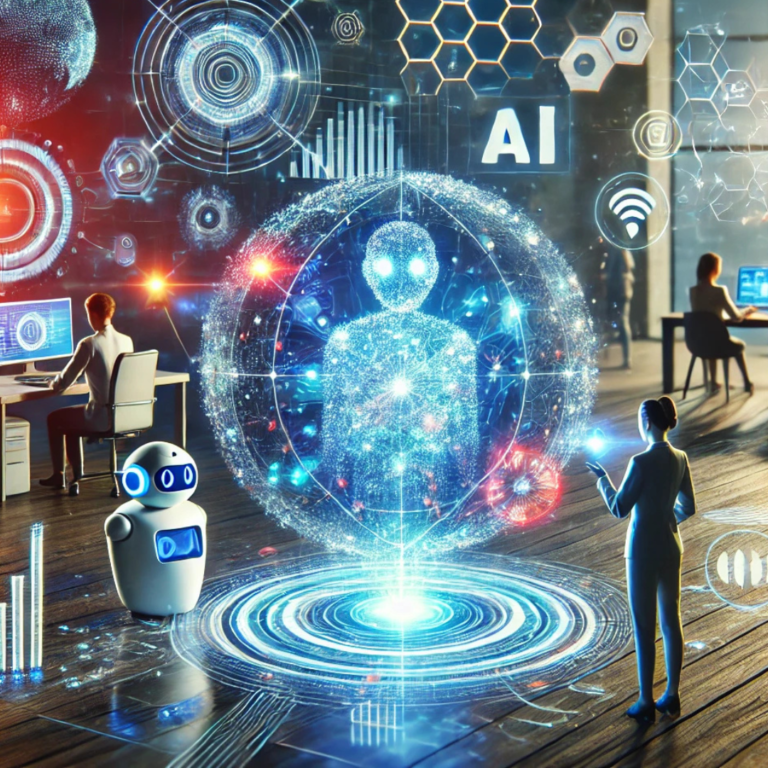Generative AI as pillar for future growth and its potential applications across industries
Generative AI has rapidly gained global traction, becoming a prominent topic of discussion across both tech and non-tech industries due to its immense value for enterprises. Over the past two years, it has emerged as a groundbreaking technology that extends the boundaries of computation, with the potential to transform art, creativity, and industry processes alike.
Organizations are actively exploring use cases for generative AI across various industries to achieve targeted outcomes as an initial step toward its adoption.
Favored by tech leaders for its ability to autonomously generate content and mimic human-like outputs, generative AI has found applications across a wide range of fields. These include marketing, customer experience, citizen engagement, and industry-specific processes such as manufacturing automation and supply chain management.
We would like to provide an overview of the general use cases of generative AI across various industries:
- One of the earliest and most widely adopted applications of generative AI is in conversational tools. These include virtual assistants, chatbots, language translation, and personalized recommendation systems.
- Another significant use case spans marketing applications, where generative AI can be leveraged based on the sensitivity of customer, citizen, or patient data, and the industry’s appetite for online marketing. Examples include social media automation, AI-powered customer support, and personalized marketing campaigns, all of which enhance organizational visibility and improve the efficiency of marketing investments.
- Knowledge management is a third cross-industry use case. Generative AI can identify and summarize existing knowledge, translate languages, and contextualize information geographically.
As technology adoption grows increasingly complex, it continues to be shaped by industry-specific needs, goals, and customer expectations. Generative AI is no exception, requiring customized approaches tailored to unique processes, regulations, and market dynamics.
To explore further, let’s dive deeper into how generative AI is being approached and adopted across various industries.
Financial domain
The financial domain has been a pioneer in adopting technology globally due to its heavy reliance on innovation, and AI is no exception, quickly gaining the attention of CIOs. Despite concerns regarding security, the realization of its full potential, and fears of being left behind in a highly competitive environment, the industry has boldly embraced change, enhancing the capabilities of financial services professionals.
Leveraging the power of LLMs (large language models), the industry is empowering financial professionals through improved knowledge management to enhance customer experiences and drive operational efficiency. Conversational AI is another area gaining significant traction, offering human-like responses and enabling complex customer interactions. ChatGPT, for example, has made a significant impact, showcasing use cases in customer service and elevating customer experiences to the next level.
This innovative initiative demonstrates the vast potential of generative AI in providing seamless access to diverse financial products, transforming customer interactions in the process.

Energy (Utilities and Oil & Gas)
The utility industry is actively exploring game-changing use cases for generative AI, particularly in content generation for sales and marketing, as well as code-generation applications. These efforts aim to enhance productivity, improve employee experiences, and deploy conversational applications for customer service and CX improvements. Knowledge management, especially crucial in addressing the challenges posed by an aging workforce in the utilities sector, is another key area of focus.
With significant potential for innovation, adaptability, and the redefinition of processes, utility companies are leveraging AI to automate tasks and drive transformation. According to the IDC “Future Enterprise Resiliency & Spending Survey Wave 2” from March 2023, the utilities industry ranks as the second-highest globally in generative AI investments for 2023, with 40% of respondents, far exceeding the global cross-industry average of 24%.
Conversely, oil and gas organizations are adopting a more cautious approach. The FERS survey indicates that only 18% of these companies are currently investing in generative AI technologies. However, 82% are actively exploring potential use cases. These include leveraging generative AI for multi-scenario simulations, predictive asset operations, generating subsurface images with fewer seismic scans in upstream operations, and creating human-like text responses for domain-specific questions to assist business leaders.
Manufacturing
Manufacturing organizations have traditionally been slow adopters of technology, and generative AI is no exception. However, there is significant potential to leverage extensive research capabilities to generate diverse content, such as text, videos, images, and virtual environments, which could drive industry momentum in the near future.
According to the IDC 2023 Manufacturing Survey, 27% of respondents are already investing in generative AI technologies, while an additional 38% are in the exploratory phase. Knowledge marketing and marketing applications are seen as areas with immediate benefits, largely due to the accessibility of user-friendly technologies like ChatGPT.
Manufacturers also anticipate that generative AI will have a substantial medium-term impact on operations, including production planning, quality control, AI-driven maintenance, code generation for programmable logic controllers, product development, design (spanning modeling, testing, and lifecycle management), and sales activities such as client data analysis and content management.
Despite its promise, manufacturing organizations face challenges in fully harnessing AI/ML potential. Many still lack adequate tools to address data availability and quality issues. IDC highlights that internal capabilities and training to effectively use AI-powered technologies and analytical tools remain insufficient in many cases.

Government
With the growing prominence of generative AI tools, they have become a widely discussed topic across various platforms, with abundant information highlighting their utility. Tools like ChatGPT, Bard, DALL-E 2, Vall-E, Stable Diffusion, and others have garnered significant attention from government administrations in a remarkably short time.
Governments worldwide are actively exploring potential use cases to initiate adoption for public convenience, driven by the rapid uptake of these technologies in other industries, which underscores the need to remain future-ready.Instances of generative AI usage in government include applications such as retrieving legal information, drafting speeches, and exploring its potential for delivering public services.In the long term, generative AI holds the promise of enhancing citizen experiences, bolstering the skills and efficiency of civil servants who often manage extensive documentation and cases, and assisting administrations facing challenges in attracting new talent.
Currently, no major government bodies in Europe, the Middle East, and Africa (EMEA) have deployed generative AI on a large scale. However, numerous concepts, pilot programs, and prototypes are being developed to evaluate its potential benefits, including improving citizen and employee experiences, driving operational efficiency, enhancing trust and compliance, advancing environmental sustainability, and addressing governance and technical challenges.
Healthcare
The healthcare sector has long been a major beneficiary of technological advancements and has quickly recognized the transformative potential of technology in reshaping service delivery.
Among the many capabilities of generative AI, its impact on knowledge management stands out as a significant enabler for fostering a more efficient and effective flow of information among healthcare professionals, ultimately leading to improved patient care.For example, generative AI can be utilized to create or enhance accurate patient histories and identify disease patterns, greatly improving the ability to make precise diagnoses and formulate effective treatment plans.
However, the successful adoption of generative AI in healthcare is constrained by challenges related to data and models. These models require extensive training on large volumes of high-quality data, but healthcare data quality often varies, and its availability is frequently limited due to privacy and ethical concerns. Furthermore, the probabilistic nature and intricate architecture of generative AI models can lead to reproducibility challenges, which may undermine their reliability and trustworthiness, particularly in supporting clinical decision-making processes.
Retail
The fast-paced retail industry faces constant challenges from evolving customer expectations, intense competition, and shifting customer experiences, driving the sector to explore emerging technologies to meet these demands effectively.
In 2022, headlines were filled with stories of bold retailers and brands venturing into the metaverse. By 2023, however, the spotlight shifted to generative AI. While interest in metaverse initiatives among retailers has waned in favor of newer forms of spatial computing, generative AI technologies, such as ChatGPT, Dall-E, and solutions driven by large language models (LLMs) or text-to-image models, are set to bring transformative changes across the retail value chain.
IDC data reveals that 40% of retailers are currently exploring generative AI technology, with 21% actively investing in its implementation for the coming year. Applications of generative AI are already evident in areas like product development, merchandising, supply chain optimization, marketing, and customer experience.Companies such as Coca-Cola, Mattel, and Carrefour are experimenting with generative AI solutions, albeit on a limited scale, leveraging a test-and-learn approach to uncover its potential.
IDC findings indicate that 50% of retailers plan to prioritize generative AI use cases for marketing within the next 18 months. Notably, generative AI is expected to have a significant impact on automating and personalizing resource-intensive and time-consuming e-commerce tasks, such as creating product descriptions, generating images and videos, and developing marketing copy.
Overall, as highlighted by IDC data, marketing—especially digital marketing—emerges as the primary area of generative AI investment for retail marketers. By leveraging generative AI for text and image creation, retailers can significantly enhance and streamline the e-commerce shopping experience, ultimately boosting the profitability of their online channels.
Future of Generative AI Model
Generative AI is a fascinating field poised for rapid evolution, requiring technologists to carefully evaluate real-time use cases and implement tailored strategies for different industries.
By developing a clear understanding of the technology, organizations can unlock the full potential of generative AI applications, revolutionizing how businesses are managed and significantly improving efficiency and productivity.
However, amidst the growing excitement and widespread attention, it is crucial to approach the topic with discernment. Analyzing use cases with tangible, real-world results is essential for both tech vendors and end-user organizations.
Practical applications and real-world experiences offer invaluable insights, helping distinguish between inflated promises and genuine advancements. By focusing on use cases and seeking measurable outcomes, a deeper understanding of the true potential and limitations of generative AI can be achieved.
Additionally, insights from industry experts with hands-on experience provide a reliable and current perspective, making them an indispensable resource for navigating the evolving landscape of generative AI.

